RUNNING ARDUINO ON BESPIN
– March 1st, 2009
Can you imagine Arduino’s IDE running as an online service? Since Mozilla labs just launched the Bespin IDE for Firefox we see that just a little closer. During the monthly Arduino Southern Scandiland meeting #4 that took place today at K3 in Malmo, Olle and Peter went into adding Arduino’s syntax highlighting toBespin. Just as a proof of concept they posted the following video on vimeo.
If you are interested in trying this out, you will have to install Bespin, get the server to run, and patch the system with this code. As I type Olle is trying to get some inline commands to compile his sketch. Once he has done that, we will be able of compiling Arduino code from Firefox!
Peter brought his Bug from Buglabs.net and we installed both on my Linux machine and on someone’s Mac. I want to see how far that project goes, it is really interesting the way it allows for physical connectivity of different artifacts and how easy it is to reconfigure it. There is a lot to learn from the work made by the developers. A pity I don’t own one myself and Peter had to get it with him.
Our day passed discussing mostly about software and cakes (Dave brought some birthday left overs). We were planning for a better way to push news to the main site, but also to publish information about workshops and community events. We made some planning on how we want to implement adding new boards and libraries to the IDE, how to dinamicaly compile libraries and how to restructure the folders to make updating easier. We see a RSS enhanced future shinning in front of us, but also a lot of Javascript, online documentation, and online project sharing.
ARDUINO DUEMILANOVE UPGRADED TO THE ATMEGA328
– February 28th, 2009
We’re very happy to announce that the Arduino Duemilanove has been upgraded to a more powerful microcontroller: the ATmega328. It’s fully compatible with the previous ATmega168, but with twice the memory. That includes flash memory for storing sketches (32 KB instead of 16 KB), RAM for holding variables (2KB instead of 1KB) and EEPROM for saving data when turning off the board (1 KB instead of 512 bytes). We’ve also raised the speed (in the bootloader) for uploading new sketches from 19200 baud to 57600 baud.
Thanks to some tough negotiating by Gianluca Martino of Arduino and Smart Projects, this won’t raise the price of the board. Look for distributors to roll out the upgraded boards soon. Current Duemilanove or other Arduino boards can be upgraded by replacing the ATmega168 with a bootloaded ATmega328 (you’ll need to buy a pre-bootloaded one or use a hardware programmer). Be sure to select “Arduino w/ ATmega328″ from the Tools > Boards menu.
WIRED ITALY
– February 28th, 2009
HOW DOES ARDUINO SOUND IN ITALIAN?
– February 25th, 2009
Shining from freaknet.org passed by our lab in Malmo and wrote a nice article in Italian about K3 but mainly about Arduino. If you want to get an insight to the project and to Scandinavian academia written by an Italian activist, just check the following link:
GOING FOR A ONE NIGHT HACK
– February 19th, 2009
If you have nothing better to do during a winter night in Sweden, you can always hack a couple of libraries together and make a third one. SDplayWAV is for people interested in playing sounds from SD cards. Builds upon previous work by Ladyada, Ronald Riegel, and Michael Smith.
I felt like shooting a movie out of tonight’s work. The camera wasn’t that good, but youtube video annotations made my night 
MICROSD MODULE FROM LIBELIUM
– February 17th, 2009
I am starting my review series talking about the microSD module from Libelium. It is a tiny board (45x23mm) that can be used with any microcontroller platform able of communicating over SPI. I got it with a 1GB microSD card and a set of male headers that allow connecting the board to the digital pins 8 to 13. It is also possible to connect the board directly to Arduino’s programming header, since the SPI port is the one used to burn the Arduino bootloader.
The nice thing about the microSD module is that when connected to the digital pins, you won’t need any other wires to get it to work. Pulling pin 8 to HIGH is enough to power up the SD card. Libelium, on their wireless sensor networks website, have made great documentation of their board.
I am writing some code examples for them for some months now. We work together in some other open source project. I ask if it was OK to pre-release some of the code I am making for them regarding SD cards. After getting a green light, I invested my Sunday night in making a nice library for this article to be found at my open source repository.
I have now a good tool to push data into the card (with some limitations), read existing files, append strings to files, log sensor data or play pre-recorded sounds (more to come on this topic). The module’s form factor make it great to be included in many of the projects I face in my everyday work. I hope I hadn’t given Dave Mellis the second microSD module we got.
Remember you can win one of this modules if you participate in Libelium’s design contest. If you cannot wait that long, it is not expensive to get one and start with your experiments.
If you want more references about this design on Arduino.cc, visit:
- http://www.arduino.cc/playground/Learning/SDMMC
- http://www.arduino.cc/playground/Main/SimilarBoards
- http://www.arduino.cc/playground/Main/Resources
- http://www.arduino.cc/playground/Main/SimilarBoards
- http://www.arduino.cc/playground/Main/Resources
For getting the board’s code:
For getting the board:
XMAS PRESENTS – REVIEWING PRODUCTS
– February 17th, 2009
I got a whole bunch of Xmas presents this year and I promised myself to take some time to make high quality stuff out of them. Libelium, the Arduino distributor running the Hacking Life contest, sent two pieces of their microSD module, two GPSs, two Solar panels, two GPRS modules, and some other small things.
I also got the Mignon Arduino compatible game by the German artist and designer Olaf Val. From the Roboduino guy (Eric) I got a hand soldered servo control board with my name written on it that I will keep close to my heart (I love hand-soldered boards) and from Smartprojects I got the Arduino Colorspecial edition.
I am going to revise each one of those products, post about them here and document some on the Arduino playground. If you are into manufacturing Arduino related products and want a review by one of us in the team, we are open for discussion, we like presents.
PLANKS
– February 16th, 2009
During the last year we have been involved in the process of conceptualizing, constructing, programming, and debugging an installation for a Danish group composed by Anna Vallgarda and Henrik Menne, commissioned by the IT University, Denmark.
They are a series of 9 planks controlled by Arduino Diecimila boards withSmaplerV2 as interface to microphones, servo motors, and some sensors. Each one of the planks will behave independently and react to sound. They will flex to the sound to a point you never imagined you’d see wood flexing.
We learned a lot about how to design interactive furniture, it is not just about making reactive pieces of ambient devices. There are a lot of practical issues when it comes to the configuration of them, the difference in the way wood will beahave in each plank, the place where they will be shown … these planks even got a password to connect to them and modify their behaviors!
After two hardware iterations, 14 software revisions and two different construction try-outs (one in 100% wood, one with metallic mechanics but wooden surface) it is time to announce the birth of a new interactive installation. If you are in Copenhagen this Thursday, come to the opening, I will be there.
It is also time for the credits, besides Anna and Henrik -who came with the idea and the funding-, Marcus Eriksson, James Haliburton, Tony Olsson, Donghoo Kim, David Sjunnesson, Fernando Barrajon, Andreas Goransson, Mattias Nordberg, Keongook Seok, and the one writing (D. Cuartielles) have been involved in making this piece as it is. All of you guys deserve credit, thanks for the good work.
Here the official flyer for the show. I will post a video once I have been to the opening.
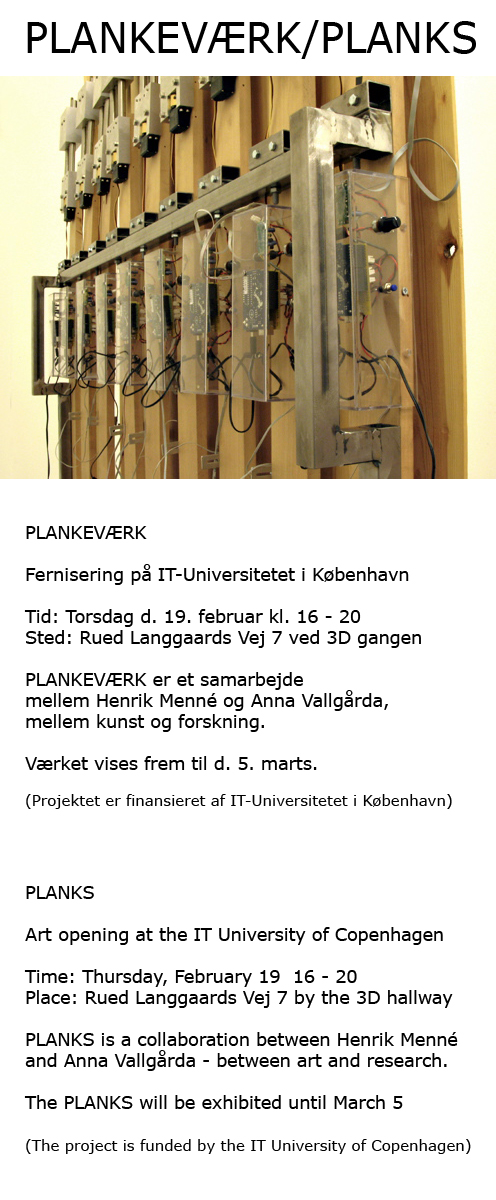
(c) 2009 picture courtesy of Anna Vallgarda, ITU Copenhagen
TIME TOYS AT K3
– February 13th, 2009
This week we had mid-course presentations at K3′s first year class in Physical Prototyping. The brief was to create toys or digitaly agmented board games playing with the issue of time. We have been running this course about four times in the last 6 months and the results are just getting better.

(c) 2009 by D. Palmer, D. Osterlind, and L. Wallin, K3
As usual, the brief is open and students are free to re-interpret it and make anything they like out of it. Music Time! is one of those projects that breaks with the pre-established brief and ends up being really good. Playing with time at a micro level and with how analog recording platforms (cassette tapes) store and reproduce sound can become an interesting game.
(c) 2009 by D. Palmer, D. Osterlind, and L. Wallin, K3
If you are interested in K3′s open lecture system, you are more than welcome to follow up the courses Physical Prototyping I and Physical Prototyping II. David Sjunnesson from 1scale1 is kindly posting all the pictures of this year’s projects on his flickr page and you can find most of the works on youtube by just looking for the tags “k3″ and “PP1″ or “PP2″
CIID – TANGIBLE USER INTERFACES
– January 31st, 2009
The Copenhagen Institute for Interaction Design is running the Interaction Design Pilot Year in collaboration with the Danish Design School. Dave Mellis works there, Massimo was teaching a basic Arduino course some months ago, and I just finished a short position as advisor for their Tangible User Interfaces course. It has been an intense four weeks period where I helped out with the conceptualization of projects, and their technical realization.
The course responsible -Heather Martin- was also one of the brains behind the remarkable “Strangely Familiar” class that ran at the Interaction Design Institute Ivrea some years ago and that produced physical computing pieces that are nowadays reference for many courses around the world.
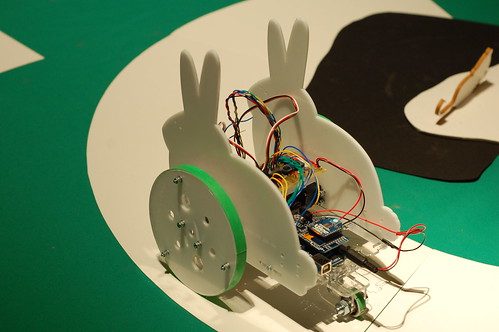
(c) 2009 CIID - picture by D. Cuartielles
CIID owns a small but pretty red laser-cutter that was broadly used by the students during the development of their projects. I have collected some pictures about the results, you could access them at my flickr account. I haven’t named the objects properly in there. If you are interested in referencing them, you should use the following names:
- Meet the food you eat: a project about scaling the food you eat in terms of the carbon emissions to get it to you. You will compare the food you eat with the trees that will get cut. It runs with an Arduino board controlling a stepper motor, an RFID reader and a hacked scale (from IKEA)

(c) 2009 CIID - Picture by D. Cuartielles
- Dubmate: P2P meets mix-tape, now that filesharing online is becoming more and more complicated, it would be nice to have a way to share files with your pals when meeting them face to face. Make them feel special by passing them your personal selection. This project was solved with self-made boards using Lilypad’s bootloader, some touch sensors from Omrom and a lot of stickers
- Easyrun: what if you go for a run using your iPhone as a music player? And if you get a call? Do you want to be looking at the screen while you do it? This garment will help you controlling the phone with just three soft buttons. Made with a bootloaded ATmega and some digital potentiometers
- Compound Eye: imagine a set of networked cameras that can take pictures simultaneously when one of them is triggered. This is like the digital version of the LOMO camera, that allows real time projections at parties, events, etc. The project included a whole bunch of cameras, one Arduino board, some buttons, and some clever coding in Processing
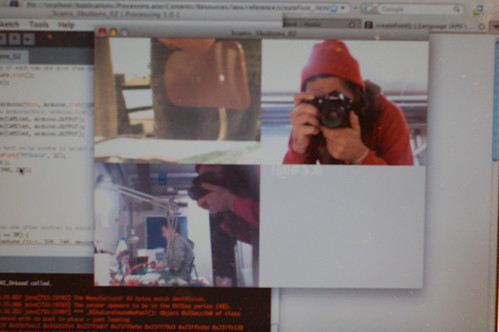
(c) 2009 CIID - Picture by D. Cuartielles
- FlirtyCup: a set of networked bar glasses that allow people meeting others with similar interests. Offers room for personalization via some printed flyers around the glasses. The project was made with Arduino Pro mini, XBee radios,MicroBee boards (by BlushingBoy), potentiometers and RGB LEDs
- Frontline Gloves: gesture enhanced gloves for firemen. Imagine going around in a smoky room carrying something in one hand and still needing to inform the others about your status. It has the added feature of informing you about the distance to objects in the room. It was solved with Arduino, XBee shield, Ping sensor (ultrasound), some LEDs and a self made silicon display
- 3D calendar (aka CAL3NDAR): a physical calendar for autistic kids. It includes the possibility of displaying events with (printed) pictures, objects and sound recordings. It was built out of ISD flash-sound chips and self made Arduino boards that will trigger the recorded sounds when bringing one of the items out of the shelf

(c) 2009 CIID - Picture by D. Cuartielles
- BunnyBot: resembles Alice in Wonderland with a robot rabbit and an augmented game board. It is a collaborative game where the players have to guide a the BunnyBot through a ad-hoc map on the floor. The goal is to achieve a certain amount of goals in the shortest time possible. The control of the white rabbit is distributed among the players. The colored items on the floor will affect the controls. It was made re-appropriating the models for the Arduino Servo Robot making one of the sides look like a rabbit, adding an XBee shield to remote control the robot and a color sensor to distinguish the floor
There was yet another project in the show, I will however wait until the documentation for it is ready before I blog about it … the guys worked a lot for getting it up and running but happend to die of demo effect short before the show and they deserve a post just for themselves.
Update 20090201: Dave Mellis just uploaded his collection of pictures to flickr, you should check them out, he’s got plenty of shots showing the process of making the prototypes and images like the following where you can see Durrell Bishop, one of the most relevant designers dealing with interactive installations and devices. He flew from London to act as reviewer.
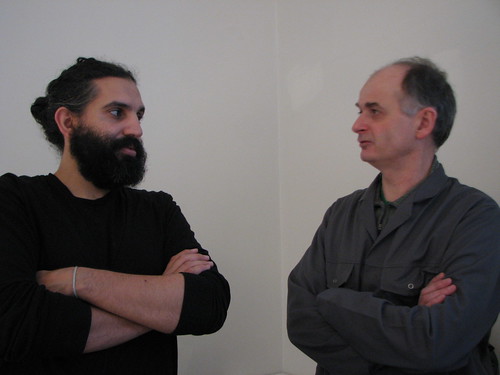
(c) 2009 CIID - Picture by D. Mellis




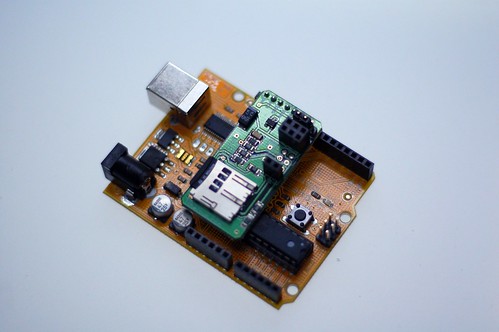
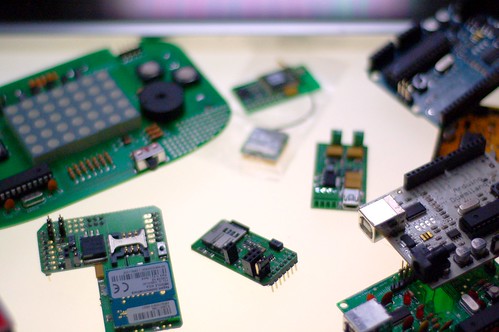






0 comentarios:
Publicar un comentario